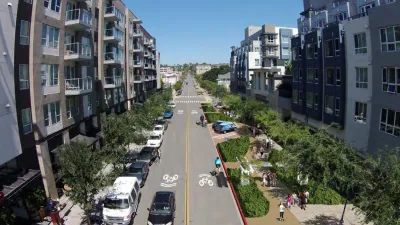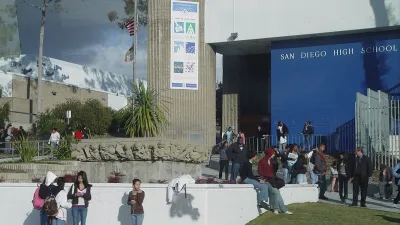Downtown San Diego’s waterfront is undergoing major changes. Regarding the latest proposal, the San Diego Environment + Design Council has some words of advice in this open letter to the Port District.
The San Diego Unified Port District Commission has selected one of six proposals for a redevelopment of 77 acres of waterfront, including the popular Seaport Village. This redevelopment proposal would include, among other things, a 500-foot spire featuring a gondola ride, a beach, "an aquarium park," a pier, a floating pool, park space, a plaza for markets and events, an amphitheater, a dock for paddle boarding, a market area "similar to Pike Place," and, of course, retail space.
The San Diego Environment + Design Council, a coalition of organizations promoting environmentally-sustainable land use policies, has some concerns and advise:
Connect – The new waterfront area "should have obvious and functional physical and programmatic links to the downtown. . . continuation of the grid network to the water could enhance both the physical and visual connection to the Bay from the core, which is largely missing."
Not just for tourists – "include an array of tenants serving practical needs for downtown residents and displaying works of local artists."
Focus on the Bay – "The primary 'draw' should be San Diego Bay, and not shops and restaurants proximate to it."
Don’t overpower – "Proposed structures should not overwhelm the site with excessive bulk, excessive mass, excessive height, or crowding the waterfront by being too close to the edge."
Architecture – should be distinctive but should not distract from the beauty or history of the area – It should not be "a depiction of false history, nor something so trendy as to risk aging poorly."
Hotel set back – "hotels should not be in a waterfront park, but adjacent to it."
Retail and Restaurants – "...should assume a secondary position to the primary focus and purpose of the project site – free public access to, and the enjoyment of, San Diego Bay."
Multi-purpose public spaces – "public plazas [should] emphasize unprogrammed free play, quiet enjoyment, and San Diego Bay views, aromas, and sounds.”
Public art – "The public realm should have permanent fixed art of international prominence, and opportunities for outdoor performing arts."
Dynamic experiences – encourage "ever changing array of colorful outdoor building-free street vendors with carts, crafts, foods, and performances."
Timeless design – Require development with "high quality durability, flexibility, functionality, and material finish...Fine grain details..." with a "distinctive San Diego flavor."
Water Oriented Facilities – Include a public beach, "piers, overlooks, and wharves, free and open to the public.”
Commercial fishing operations – retain the tuna boat fleet—it provides an "authentic element . . . and link to San Diego’s maritime history."
Parking and mobility improvements:
PARK AND RIDE/WALK – "uses that require vehicle access for drop-offs, or service deliveries, [should be] positioned away from the waterside...."
And most importantly, part of the comprehensive planning process –
[A]n open and comprehensive planning and development process is essential. . . We recommend that no action on this particular parcel proceed until the Port District completes and adopts a Comprehensive Master Plan Update. The proposed project is an unacceptable, “piecemeal” development, instead of a component of an adopted update to the Comprehensive Master Plan.
FULL STORY: Open letter to San Diego Port Commission about “world class waterfront” development proposals

Alabama: Trump Terminates Settlements for Black Communities Harmed By Raw Sewage
Trump deemed the landmark civil rights agreement “illegal DEI and environmental justice policy.”

Planetizen Federal Action Tracker
A weekly monitor of how Trump’s orders and actions are impacting planners and planning in America.

The 120 Year Old Tiny Home Villages That Sheltered San Francisco’s Earthquake Refugees
More than a century ago, San Francisco mobilized to house thousands of residents displaced by the 1906 earthquake. Could their strategy offer a model for the present?

In Both Crashes and Crime, Public Transportation is Far Safer than Driving
Contrary to popular assumptions, public transportation has far lower crash and crime rates than automobile travel. For safer communities, improve and encourage transit travel.

Report: Zoning Reforms Should Complement Nashville’s Ambitious Transit Plan
Without reform, restrictive zoning codes will limit the impact of the city’s planned transit expansion and could exclude some of the residents who depend on transit the most.

Judge Orders Release of Frozen IRA, IIJA Funding
The decision is a victory for environmental groups who charged that freezing funds for critical infrastructure and disaster response programs caused “real and irreparable harm” to communities.
Urban Design for Planners 1: Software Tools
This six-course series explores essential urban design concepts using open source software and equips planners with the tools they need to participate fully in the urban design process.
Planning for Universal Design
Learn the tools for implementing Universal Design in planning regulations.
Clanton & Associates, Inc.
Jessamine County Fiscal Court
Institute for Housing and Urban Development Studies (IHS)
City of Grandview
Harvard GSD Executive Education
Toledo-Lucas County Plan Commissions
Salt Lake City
NYU Wagner Graduate School of Public Service





























